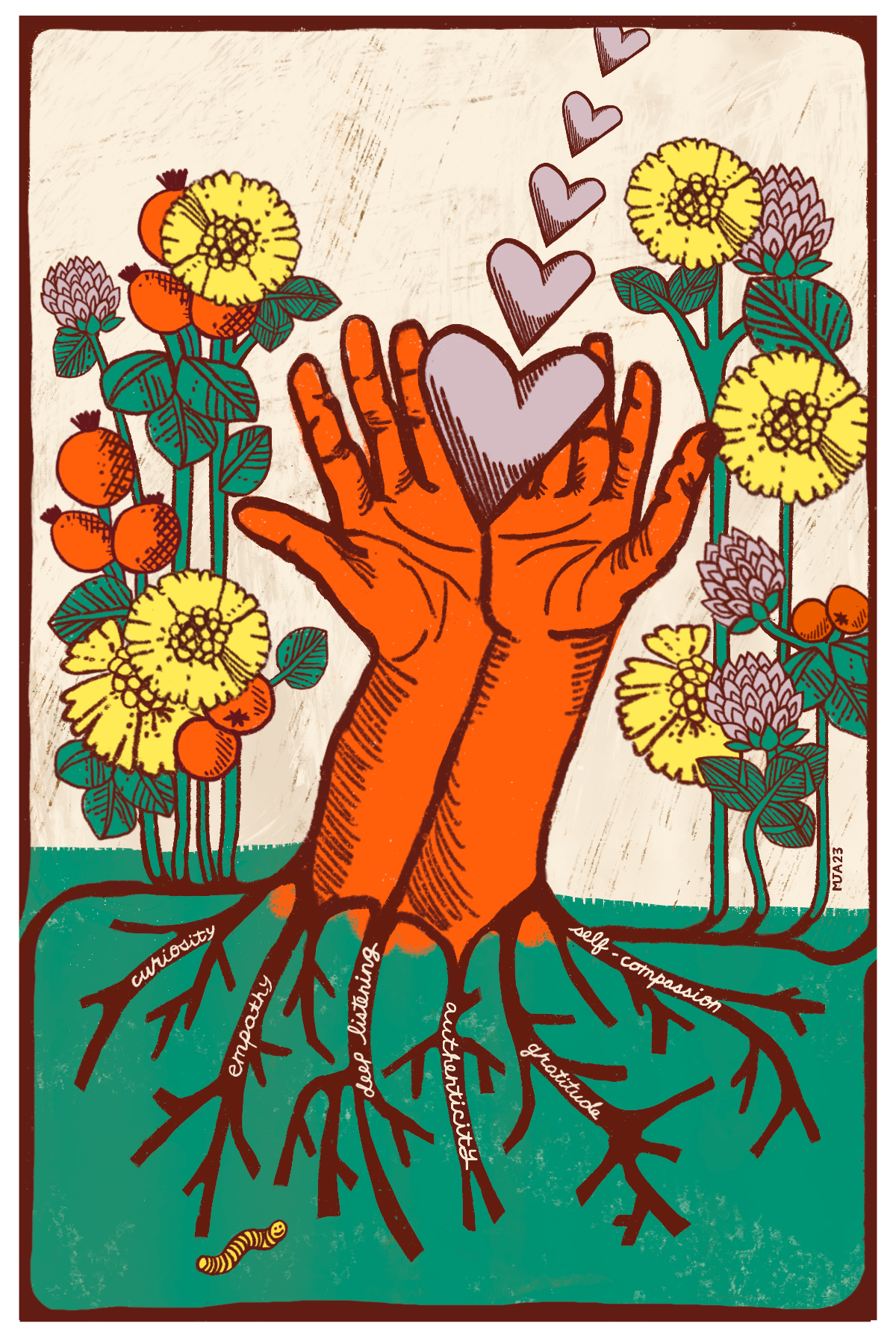By Thich Nhat Hanh on
Thầy’s commentary on the Mettā Sutta to expand our love to be all-inclusive and all-embracing
The Buddha offered many meditations on love. When a group of monks told him that the spirits living near their forest monastery were causing others to suffer, the Buddha taught the Mettā Sutta, also known as the Discourse on Love:
He who wants to attain peace should practice being upright,
By Thich Nhat Hanh on
Thầy’s commentary on the Mettā Sutta to expand our love to be all-inclusive and all-embracing
The Buddha offered many meditations on love. When a group of monks told him that the spirits living near their forest monastery were causing others to suffer, the Buddha taught the Mettā Sutta, also known as the Discourse on Love:
He who wants to attain peace should practice being upright, humble, and capable of using loving speech. He will know how to live simply and happily, with senses calmed, without being covetous and carried away by the emotions of the majority. Let him not do anything that will be disapproved of by the wise ones. And this is what he contemplates:
“May everyone be happy and safe, and may their hearts be filled with joy.
“May all living beings live in security and peace, beings who are frail or strong, tall or short, big or small, visible or not visible, near or far away, already born or yet to be born. May all of them dwell in perfect tranquility.
“Let no one do harm to anyone. Let no one put the life of anyone in danger. Let no one, out of anger or ill will, wish anyone any harm.
“Just as a mother loves and protects her only child at the risk of her own life, we should cultivate boundless love to offer to all living beings in the entire cosmos. Let our boundless love pervade the whole universe, above, below, and across. Our love will know no obstacles, our heart will be absolutely free from hatred and enmity. Whether standing or walking, sitting or lying, as long as we are awake, we should maintain this mindfulness of love in our own heart. This is the noblest way of living.
“Free from wrong views, greed, and sensual desires, living in beauty and realizing perfect understanding, those who practice boundless love will certainly transcend birth and death.”
After several months of reciting and practicing the Mettā Sutta, the monks came to understand the sufferings of the troubled spirits. As a result, the spirits began to practice, also. They became filled with the energy of love, and the whole forest was peaceful.1
______
The Buddha also offered many specific exercises to help his disciples practice and realize the Four Immeasurable Minds:
When your mind is filled with love, send it in one direction, then a second, a third, and a fourth, then above, and then below. Identify with everything, without hatred, resentment, anger, or enmity. This mind of love is very wide. It grows immeasurably and eventually is able to embrace the whole world. Practice the same way with your mind filled with compassion, then joy, then equanimity.2
With his mind filled with love, the monk permeates one direction, and then a second, a third, a fourth, above, below, and all around, everywhere identifying himself with all. He permeates the whole world with his mind filled with love, wide, far, developed, unbound, free from hatred and ill will. He does the same with his mind filled with compassion, joy, and equanimity.3
When the energy of love is strong in us, we can send it to beings in all directions. We may imagine our love as being like waves of sound or light, or like a pure white cloud that forms slowly and gradually spreads out to envelop the whole world. But the love meditation is not only an act of imagination. A true cloud produces rain. Sound and light penetrate everywhere, and our love must do the same. We have to observe whether our mind of love is present in our actual contact with others. Practicing love meditation in the sitting position is only the beginning.

Love meditation is an important beginning. We sit quietly and look deeply into ourselves. With practice, our love will increase naturally, becoming all-inclusive and all-embracing. As we learn to see with the eyes of love, we empty our mind of anger and hatred. As long as these negative mental formations are present in us, our love is incomplete. We may think we understand and accept others, but we are not yet able to love them fully. Nāgārjuna says, “At the time you practice the Immeasurable Mind of Love, you must look deeply in order to face your anger and hatred.”4
In the introduction to Nāgārjuna’s Mahāprajñāpāramitā Shastra, Étienne Lamotte, the translator, wrote, “The Four Immeasurable Minds are just platonic ideals,” mere ideas, not something that can be realized. Although Professor Lamotte was an excellent translator, he was not actually familiar with Buddhist practice. The moment we give rise to the desire for all beings to be happy and at peace, the energy of love arises in our mind, and all our feelings, perceptions, mental formations, and consciousness are permeated by love; in fact, they become love. This is no mere “ideal.” Nāgārjuna addresses this directly:
When we want beings in all directions to be happy, there arises in us the intention to love. This desire to love enters our feelings, perceptions, mental formations, and consciousness; and it becomes manifested in all our actions, speech, and other mental activities. Events that are neither mental nor physical arising after that are in accord with love and can in themselves be called love, as love is their root. These events determine our future actions, and they are directed by our will, which is now suffused with love. Will is the energy that drives our actions and speech. The same is true with regard to the arising of compassion, joy, and equanimity.5
Mindfulness is the energy that allows us to look deeply at our body, feelings, perceptions, mental formations, and consciousness and see clearly what our real needs are, so we will not drown in the sea of suffering. Eventually love fills our mind and our will, and all our actions from that time on manifest love. Speech and actions are the fruits of will, so when our will is permeated by love, our speech and actions are also suffused with love. We speak only loving and constructive words and act only in ways that bring happiness and relieve suffering.
Yet in another passage of the Mahāprajñāpāramitā Shastra, Nāgārjuna also says that the Four Immeasurable Minds are mere aspirations, that they exist only in our mind. This is much the same as Professor Lamotte’s platonic ideals. It was Nāgārjuna who provided the words for Lamotte! It helps us understand if we remember that Nāgārjuna wanted to advance the views of the newly emerging Mahāyāna Buddhism, so he wrote, “Followers of Hīnayāna practice the Four Immeasurable Minds, but the Immeasurable Minds they practice are only in the form of aspirations. The Immeasurable Minds, when joined with the pāramitās of the Mahāyāna,6 are the Immeasurable Minds of the bodhisattva that can transform the world.” In his efforts to promote the Mahāyāna, Nāgārjuna erred in saying that the Four Immeasurable Minds of the Hīnayāna are merely internal, without external manifestation. This contradicts his previous words, that when the mind of love arises, it manifests in our words and our actions. To say that love, compassion, joy, and equanimity are only aspirations that exist in the mind is not correct. We practice not only to give rise to the Four Immeasurables in our mind, but also to bring them into the world through our words and actions. When we practice love meditation, we don’t merely visualize our love spreading into space. We touch the deep sources of love that are already in us, and then, in the midst of our daily lives, in our actual contact with others, we express and share our love. We practice until we see the concrete effects of our love on others, until we are able to offer peace and happiness to everyone, even those who have acted toward us in ways that are most unlovable.
Buddhaghosa, author of The Path of Purification, tells us that when our meditation begins to bear fruit, we will recognize in ourselves these signs of a loving mind: (1) our sleep is more relaxed, (2) we do not have nightmares, (3) our waking state is more at ease, (4) we are not anxious or depressed, and (5) we are loved and protected by everyone and everything around us.7
In the Aṅguttara Nikāya, the Buddha mentions eleven advantages of practicing love meditation. The Buddha speaks in these terms — of what is advantageous and what is disadvantageous — because doing so encourages people to practice.
- The practitioner sleeps well.
- Upon waking, she feels well and light in her heart.
- He does not have unpleasant dreams.
- She is well-liked by many people. She feels at ease with everyone. Others, especially children, like to be near her.
- He is dear to the nonhuman species: birds, fish, elephants, squirrels. Species that are visible and invisible like to be near him.
- She is supported and protected by gods and goddesses.
- He is protected from fire, poison, and the sword. He does not need to make any special effort to avoid them.
- She reaches meditative concentration easily.
- His face is bright and clear.
- At the time of death, her mind is clear.
- He is reborn in the Brahma Heaven, where he can continue the practice, because there is already a Sangha of those practicing the Four Immeasurable Minds.8
In the Itivuttaka, the Buddha says if we gather together all the virtuous actions we have realized in this world, they are not equal to practicing love meditation. Building practice centers, making Buddha figures, casting bells, or doing social work cannot bring about one-sixteenth of the merit of practicing love meditation. If we collect together all the light from the stars, it will not be as bright as the light of the moon. In the same way, practicing love meditation is greater than all other virtuous actions combined.9
Practicing love meditation is like digging deep into the ground until we reach the purest water. We look deeply into ourselves until insight arises and our love flows to the surface. Joy and happiness radiate from our eyes, and everyone around us benefits from our smile and our presence.

If you take good care of yourself, you help everyone. You stop being a source of suffering to the world, and you become a reservoir of joy and freshness. Here and there are people who know how to take good care of themselves, who live joyfully and happily. They are our strongest support. Everything they do, they do for everyone. That is the meaning of Mahāyāna Buddhism. That is love meditation.
The Buddha said that if a monk practices love meditation, even if only for the length of time it takes to snap one’s fingers, that monk is worthy of being a monk: “He will not fail in meditative concentration. He will realize the teachings given by teachers on the path. The food offered to him as alms will not be wasted. There is no greater virtue than practicing love meditation every day.”10
1 Sutta Nipāta, Chapter 1, Sutta 8.
2 Madhyama Āgama, Sutra 86.
3 Subha Sutta, Majjhima Nikāya, Sutta 99.
4 Mahāprajñāpāramitā Shastra. A shastra is a treatise or commentary on the Buddha’s teachings, written by a great master after the lifetime of the Buddha. This text is available in Belgium as Le Traité de La Grande Vertu de Sagesse de Nāgārjuna, translated by Étienne Lamotte (Louvain, Belgium: Institut Orientaliste, 1949).
5 Mahāprajñāpāramitā Shastra. According to the Buddha, a human being is composed of five skandhas (elements, heaps, or aggregates): form, feelings, perceptions, mental formations, and consciousness. For a full explanation of practicing love meditation within each of The Five Skandhas, see Chapter Three [of Teachings on Love by Thích Nhất Hạnh]. “Events” that are considered neither mental nor physical are related to our mind and objects of our mind. They are listed as gain, loss, birth, death, grammar, literature, time, space, union, separation, impermanence, quantity, seeing things as similar or dissimilar, etc. Will, volition, or intention is chetana.
6 The Ten Pāramitās of the Mahāyāna are: dāna (generosity), shila (precepts), kshanti (forbearance), virya (energy), dhyāna (meditation), prajña (understanding), upāya (skillful means), pranidhāna (aspiration), bala (spiritual power), and jñāna (wisdom).
7 Bhikkhu Ñāṇamoli, trans., The Path of Purification: Visuddhimagga, The Classic Manual of Buddhist Doctrine & Meditation (Kandy: Buddhist Publication Society, 1975).
8 Mettā Sutta, Aṅguttara Nikāya, Book 11, Sutta 15.
9 Mettābhāvanā Sutta, Itivuttaka, Sutta 27.
10 Apara-Accharasanghatavaggo, Aṅguttara Nikāya, Book 1, Sutta 31.

This is an excerpt from Teachings on Love by Thích Nhất Hạnh, published by Parallax Press.


